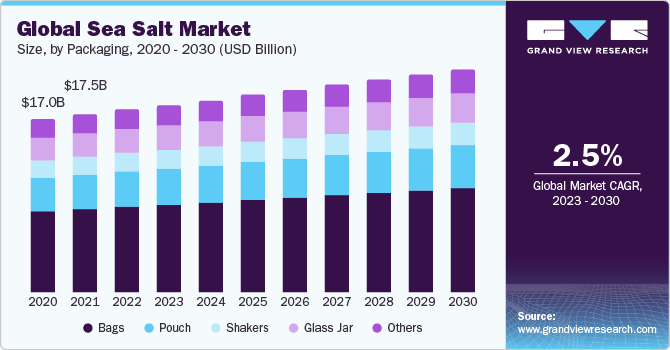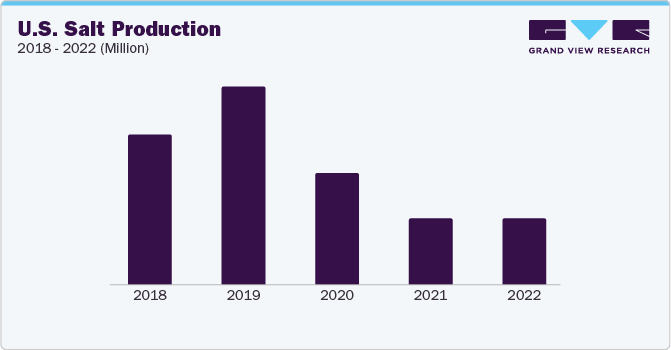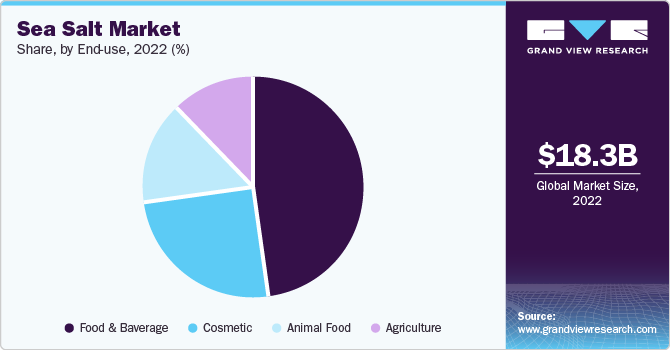- Home
- »
- Organic Chemicals
- »
-
Sea Salt Market Size, Share & Growth Analysis Report, 2030GVR Report cover
![Sea Salt Market Size, Share & Trends Report]()
Sea Salt Market Size, Share & Trends Analysis Report By Packaging (Bags, Pouch, Sacks, Shakers, Glass Jar), By Application (Regenerating Water Agent, De-Icing Agents, Detoxifying Agents), By Sales Channel, By End-Use, By Region, And Segment Forecasts, 2023 To 2030
- Report ID: GVR674737
- Number of Report Pages: 0
- Format: PDF, Horizon Databook
- Historical Data: ---
- Forecast Period: 1 - 2030
- Industry: Bulk Chemicals
Sea Salt Market Size & Trends
The global sea salt market was valued at USD 18,310.2 million in 2022 and is expected to grow at a CAGR of 3.2% over the forecast period. Sea salt's extensive utilization in diverse sectors, such as agriculture, animal feed, water treatment for plants, and ice melting, plays a pivotal role in fostering market growth. Its effectiveness in these applications, combined with its natural properties, positions the product as a preferred choice for various industries. The industry is significantly influenced by increasing demand from various industries, including food processing, and chemical production. The food processing sector, in particular, drives demand due to the incorporation of products as a seasoning and preservative.

The COVID-19 pandemic has had varying impacts on the market. While some reports suggest a neutral or overall growth forecast for the industry during the assessment period, others highlight the challenges and uncertainties brought about by the pandemic. Factors such as disruptions in the supply chain, changes in consumer preferences, and economic impacts have influenced the market. It is important to consider the specific dynamics and trends within the industry to assess the precise impact of COVID-19 on the market.
The demand for the product is driven by various factors. Firstly, consumers are increasingly seeking healthier and more natural alternatives to traditional table salt. Sea salt is perceived as a healthier option as it contains minerals and trace elements that are beneficial for the body. Additionally, the unique flavor and texture of the product have made it a preferred choice among chefs and food enthusiasts.
The use of product extends beyond the culinary industry. It is also utilized in agriculture, animal feed, water treatment, and even in the production of cosmetics and personal care products. The versatility of sea salt has contributed to its growing demand across different sectors.
Application Insights
Sea salt is widely used in water treatment processes for its ability to regenerate and improve water quality. Its high mineral content, including magnesium, calcium, and potassium, contributes to the remineralization of water, making it suitable for various applications. It acts as a natural coagulant, aiding in the removal of impurities and pollutants through flocculation. Moreover, its antimicrobial properties help in controlling microbial growth and ensuring safe water conditions. The demand for the product as a water regeneration agent is expected to increase due to the growing need for sustainable and eco-friendly solutions in the water treatment industry.

Sales Channel Insights
The market utilizes a variety of sales channels to reach its target customers. These channels include retail stores, online platforms, foodservice and hospitality. Retail stores, such as supermarkets, hypermarkets, grocery stores, and specialty food stores, provide consumers with the opportunity to directly purchase products. This physical retail presence allows customers to browse and select the products that meet their needs. In addition to physical retail outlets, online platforms play a significant role in the industry. The manufacturers and distributors of the product make use of their own websites as well as third-party online marketplaces like Amazon and Alibaba. These platforms provide convenience and accessibility for customers to purchase the product from the comfort of their homes. Furthermore, the food service and hospitality sector is an important sales channel for sea salt. Restaurants, hotels, cafes, and catering companies purchase products in bulk quantities to meet their culinary needs.
End Use Insights
Sea salt is widely used in the food and beverage industry due to its distinctive taste, texture, and nutritional value. Its mineral content, including magnesium, calcium, and potassium, adds depth of flavor and enhances the overall sensory experience of various culinary creations. From seasoning and preserving to baking and confectionery, sea salt finds its way into a diverse range of food products, including snacks, sauces, dressings, and beverages.

Sea salt's popularity in the food and beverage industry stems from its ability to enhance the natural flavors of dishes, provide a pleasant mouthfeel, and reduce the need for excessive sodium content. Additionally, the growing consumer preference for natural and organic ingredients has further fueled the demand for products in this segment. With the rising focus on healthy eating and clean label products, the market for food and beverage applications is expected to witness significant growth.
Regional Insights
North America dominated the largest market share in 2022. The demand for market in the North American market is growing steadily. Factors such as increasing consumer awareness of the health benefits of products, the rising popularity of gourmet and artisanal food products, and the demand for low sodium alternatives are driving this growth. Additionally, the demand for market in various industries, including food processing, pharmaceuticals, and chemical production, further contributes to the overall demand in the North American market.
Competitive Insights
Key players operating in the market are INFOSA, Amato Food Product, Morton Salt Inc, Qinhai Salt Lake Industry Co. Ltd., Tata Salt, Cargill. Inc., Sea Salt Superstore, San Franisco Salt Company, and Olde Thompson Inc. The market participants are constantly working towards new product development, M&A activities, and other strategic alliances to gain new market avenues.
Share this report with your colleague or friend.
![gvr icn]()
NEED A CUSTOM REPORT?
We can customize every report - free of charge - including purchasing stand-alone sections or country-level reports, as well as offer affordable discounts for start-ups & universities. Contact us now
![Certified Icon]()
We are GDPR and CCPA compliant! Your transaction & personal information is safe and secure. For more details, please read our privacy policy.
We are committed towards customer satisfaction, and quality service.
"The quality of research they have done for us has been excellent."





